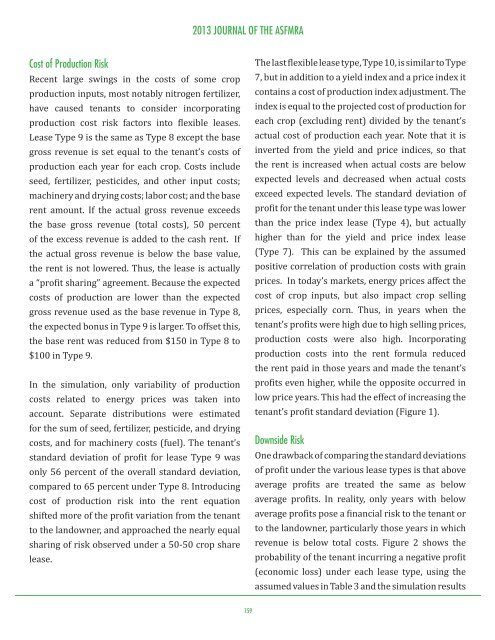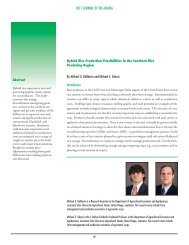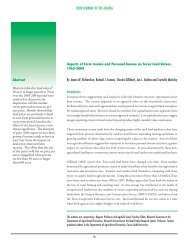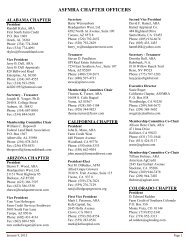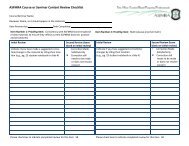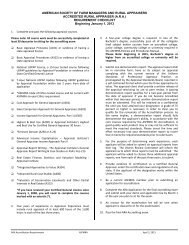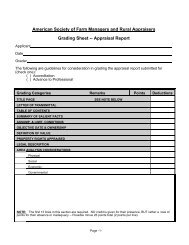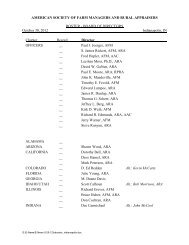Sharing Financial Risk through Flexible Farm Lease Agreements
Sharing Financial Risk through Flexible Farm Lease Agreements
Sharing Financial Risk through Flexible Farm Lease Agreements
Create successful ePaper yourself
Turn your PDF publications into a flip-book with our unique Google optimized e-Paper software.
2013 JOURNAL OF THE ASFMRA<br />
Cost of Production <strong>Risk</strong><br />
Recent large swings in the costs of some crop<br />
production inputs, most notably nitrogen fertilizer,<br />
have caused tenants to consider incorporating<br />
production cost risk factors into flexible leases.<br />
<strong>Lease</strong> Type 9 is the same as Type 8 except the base<br />
gross revenue is set equal to the tenant’s costs of<br />
production each year for each crop. Costs include<br />
seed, fertilizer, pesticides, and other input costs;<br />
machinery and drying costs; labor cost; and the base<br />
rent amount. If the actual gross revenue exceeds<br />
the base gross revenue (total costs), 50 percent<br />
of the excess revenue is added to the cash rent. If<br />
the actual gross revenue is below the base value,<br />
the rent is not lowered. Thus, the lease is actually<br />
a “profit sharing” agreement. Because the expected<br />
costs of production are lower than the expected<br />
gross revenue used as the base revenue in Type 8,<br />
the expected bonus in Type 9 is larger. To offset this,<br />
the base rent was reduced from $150 in Type 8 to<br />
$100 in Type 9.<br />
In the simulation, only variability of production<br />
costs related to energy prices was taken into<br />
account. Separate distributions were estimated<br />
for the sum of seed, fertilizer, pesticide, and drying<br />
costs, and for machinery costs (fuel). The tenant’s<br />
standard deviation of profit for lease Type 9 was<br />
only 56 percent of the overall standard deviation,<br />
compared to 65 percent under Type 8. Introducing<br />
cost of production risk into the rent equation<br />
shifted more of the profit variation from the tenant<br />
to the landowner, and approached the nearly equal<br />
sharing of risk observed under a 50-50 crop share<br />
lease.<br />
The last flexible lease type, Type 10, is similar to Type<br />
7, but in addition to a yield index and a price index it<br />
contains a cost of production index adjustment. The<br />
index is equal to the projected cost of production for<br />
each crop (excluding rent) divided by the tenant’s<br />
actual cost of production each year. Note that it is<br />
inverted from the yield and price indices, so that<br />
the rent is increased when actual costs are below<br />
expected levels and decreased when actual costs<br />
exceed expected levels. The standard deviation of<br />
profit for the tenant under this lease type was lower<br />
than the price index lease (Type 4), but actually<br />
higher than for the yield and price index lease<br />
(Type 7). This can be explained by the assumed<br />
positive correlation of production costs with grain<br />
prices. In today’s markets, energy prices affect the<br />
cost of crop inputs, but also impact crop selling<br />
prices, especially corn. Thus, in years when the<br />
tenant’s profits were high due to high selling prices,<br />
production costs were also high. Incorporating<br />
production costs into the rent formula reduced<br />
the rent paid in those years and made the tenant’s<br />
profits even higher, while the opposite occurred in<br />
low price years. This had the effect of increasing the<br />
tenant’s profit standard deviation (Figure 1).<br />
Downside <strong>Risk</strong><br />
One drawback of comparing the standard deviations<br />
of profit under the various lease types is that above<br />
average profits are treated the same as below<br />
average profits. In reality, only years with below<br />
average profits pose a financial risk to the tenant or<br />
to the landowner, particularly those years in which<br />
revenue is below total costs. Figure 2 shows the<br />
probability of the tenant incurring a negative profit<br />
(economic loss) under each lease type, using the<br />
assumed values in Table 3 and the simulation results<br />
159


